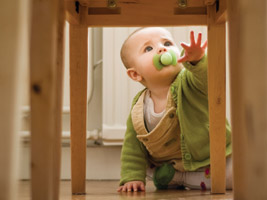
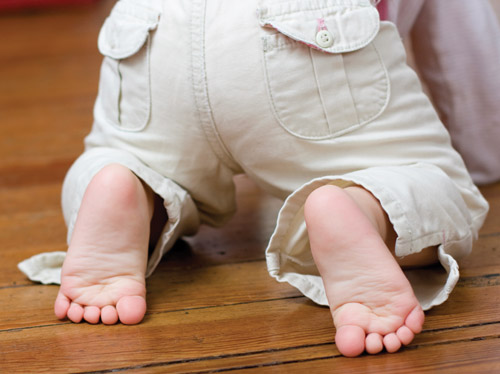
By Leslie Ayers
When I think of babyproofing, I recall a scene in Baby Mama in which Tina Fey walks into her bathroom to find Amy Pohler squatting atop the sink to pee. Why? Pohler’s character—Fey’s birth surrogate—can’t figure out how to undo the babyproof toilet-seat lock.
The purpose of babyproofing your home is, of course, to protect your baby from certain hazards so she can grow, develop, and explore without getting hurt.
I polled a couple dozen moms of small children about their babyproofing tactics. All pointed out that babyproofing isn’t something you do once and you’re done. Menlo Park, CA, mom Kathleen Castaillac points out, “Babies are smarter than you think. We realized early that we had to be proactive as we saw things that might be ongoing safety issues.”
Jamie Schaefer-Wilson, author of Consumer Reports Guide to Childproofing & Safety, herself a mother of girls age 4 and 8, also weighs in. “We don’t want people to be afraid of it,” she says. “You do all this so you can relax.”
Pre-birth to 3 months
Aside from choosing a surrogate with the mental capacity of a goldfish, Tina Fey’s biggest rookie move in Baby Mama was to install that toilet lock too soon. Why do that before baby is even born?
That said, there are quite a few tasks you can and should do before baby’s arrival—and if not before that, then certainly while she’s still a crib potato.
Cover all electrical outlets.
There are lots of options here, but I recommend replacing your existing outlet plates with the kind that have spring-loaded plug covers. We like Especially for Baby Slide and Spring Outlet Covers ($4 for 2, babiesrus.com). With the spring-loaded covers, as soon as you remove a plug, the cover slides back over the outlet—no loose covers to worry about! For outlets that don’t fit these covers, use individual plug inserts that cannot easily be pried out by tiny fingers and choked on.
Move dangerous items stored in lower cabinets.
Do a sweep of your entire home. In the kitchen, relocate cleaning supplies, insect sprays, and other chemical-laden substances from lower cabinets, drawers, and shelves to high-up locations your baby will never be able to reach.
In the bathroom, move cleaning supplies and anything hazardous (mouthwash, razors) out of lower drawers and cabinets to higher ones. All medications, toothpaste, and first-aid supplies such as rubbing alcohol and antibiotic ointment should be kept up high, too.
If you can’t move these items, lock the cabinets that contain them. Do this now to get used to undoing the latches or locks.
Secure heavy furniture and unmounted flat-screen TVs.
Dressers, armoires, and bookcases taller than 3 feet should be anchored to the wall with furniture straps. “Be sure furniture straps are secured to a wall stud, not just lathe and plaster,” says Consumer Reports’ Schaefer-Wilson. “If you can’t get to a stud, use an L-bracket and secure it to the floor. You need to find a method to secure that furniture.”
Flat-screen TVs are top-heavy, and if yours isn’t wall-mounted, put it on your honey-do list to install a heavy-duty strap or other means of securing the unit to the wall behind it or to the back edge of your TV stand.

4 to 9 months
If you followed the advice for the previous stage, you’ll be ahead of other new parents—not that you’ll have the energy to gloat.
Somewhere in this phase, your cooing, cuddly lump starts to roll over and move on her own. Any object within reach of her chubby digits is fair game. Whatever’s on the floor could end up in her mouth and down her throat. Stairs are another common hazard.
Keep floors debris-free.
If this is what it takes to get you to sweep or vacuum regularly, all the better! Get down on your tummy and scooch across the floor to get an idea of what baby might come across as she crawls around.
Block stairs and select doorways with a baby gate.
Schaefer-Wilson says gates in any home with stairs are non-negotiable. “Children tend to stand right at the top of the stairs,” she says. Without a gate to block their path, it’s not a matter of if but when they might take a header.
“Never put a pressure-mounted gate at the top of the stairs,” Schaefer-Wilson adds. “Put that at the bottom. Use something that’s secured to the wall with hardware at the top of the stairs.”
Lock lower cabinets containing toxic items.
You can install interior cabinet and drawer latches, fancier magnet-based locks, or just use external cable locks that fit your cabinets’ hardware. And even if you rethink your choice of cleaning products and replace them with non-toxic alternatives, even rubber gloves, brushes, sponges, and rags should still be locked up.
Move potted plants.
Potted plants on floors and low tables are at just the right height for baby to belly up to handfuls of soil or leaves for a taste test. “Everything goes in the mouth—every single thing,” Schaefer-Wilson warns.
9 to 16 months
Congrats—you and baby have survived this long. But you have to stay out in front of what she might get into next.
Referring to her 3-year-old daughter, Oakland, CA, mom of two Vida Barham says, “She was always a step ahead and got into things we hadn’t thought to babyproof. By the time we’d found the gadget to do so, she had moved on to something else.”Yet another reason to think ahead!
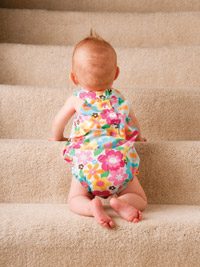
Lock all doors leading outside.
When walking becomes her prime mode of transit, baby will naturally want to use the same doors you do. Lock, or use knob and lever covers, on all doors leading outside, and keep her where you want her. There are also electronic sensors you can install on doors to sound a warning when they’re opened.
Babyproof bath time.
Once baby can sit up on her own, she’s probably ready to have you bathe her in the tub, with some precautions. If your tub doesn’t have a slip-proof coating on the bottom, get an anti-slip mat. To keep baby from trying to stand up to reach your bath products, move them out of sight. And lower your water-heater temp to 120 degrees, so the bath water can’t get hot enough to scald her.
Modify your kitchen routine.
Stove guards, oven-door locks, and stove-knob covers are only part of the solution. Whenever you’re cooking with baby in the kitchen, make sure you can always see her. Turn pot handles in toward the back of the stove. Don’t let the ends of utensils—especially knives—hang over counter edges.
Stay on it.
Remember, your baby’s developing more every day, so your safety measures need to be adaptable and changing too!
Get in Gear
Shine a Light
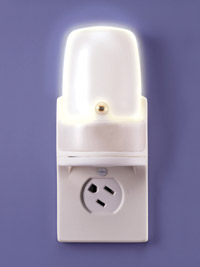
Cover a dual AC outlet with the Safety 1st Dim ’n Bright Auto Sensor Night Light and shield one outlet and a spring-loaded cover on the other.
($10, www.safety1st.com)
More Power to Ya
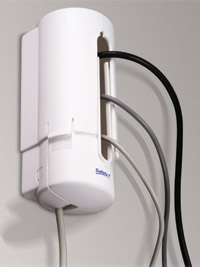
The Safety 1st Power Strip Cover hides cords and plugs on power strips so baby can’t get to them.
($8, www.babiesrus.com)
Lock ‘N Load

External cable locks are a good way to secure lower cabinet doors when you can’t install interior locks. Dream Baby’s Cable Lock opens with a combo.
($20 for 2, www.target.com)
Screen Dream
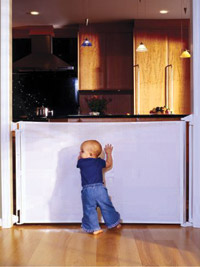
Lascal’s Kiddy Guard trumps other gates with its retractable mesh design. Because there’s no hardware spanning the threshold, there’s nothing to trip over.
($129, www.lascal.se)
Rated B for Baby
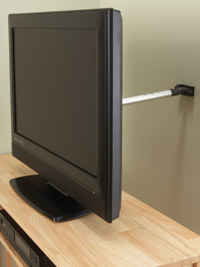
Top-heavy flat-screen TVs should be secured to a wall to prevent tipping. The Safety 1st Professional Grade Flat Screen TV Lock offers a solution.
($30, www.toysrus.com)
By Tooth and Rail
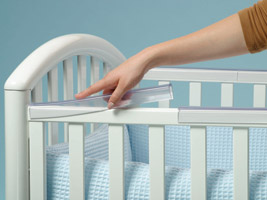
Turn your crib rail into a teether with the Prince Lionheart Crib Rail Teether. It’s phthalate-free!
($13, www.princelionheart.com)
On Edge
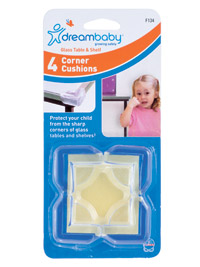
Prevent bumps on the noggin from sharp corners with Dream Baby Glass Table & Shelf Corner Cushions.
($6 for 4, www.amazon.com)
No Tips Necessary
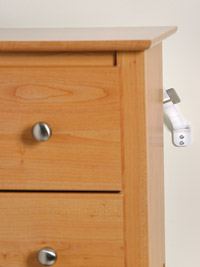
Furniture over 3 feet tall should be anchored to the wall. Safety 1st Furniture Wall Straps work!
($8, www.safety1st.com)
Water World
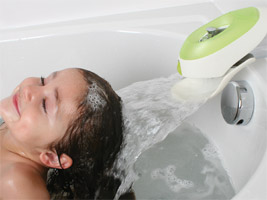
The Boon Flo faucet cover diverts water flow to form a “gentle waterfall” while covering the hard faucet.
($15, www.booninc.com)
Contributing writer Leslie Ayers knew her babyproofing regime was flawed the day 2-year-old Marlo came running down the hall waving the toilet brush, exclaiming, “Look, Mommy, a magic wand!”


Leave a Reply